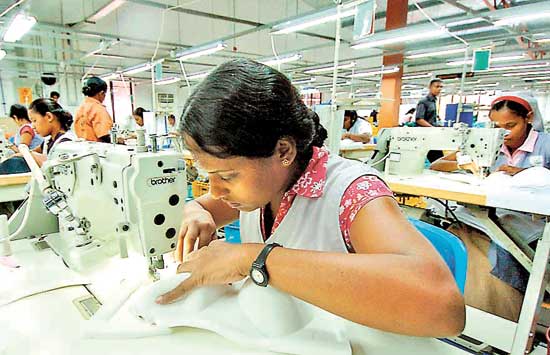Thorns in the Rose Garden
View(s):“You see what’s going on. Pakistan, 58 per cent; Sri Lanka, 88 per cent. So, what we’re doing is we’re taking not the full; we could take the full 88 per cent….”
Sri Lanka, classified among the “worst offenders” by the US, is part of a group of countries with the highest reciprocal tariffs imposed by the US. This group includes Vietnam, Cambodia, Madagascar, Myanmar, Laos, and Lesotho.

Sri Lanka’s main industrial export, garments is the worst affected sector by the US tariffs.
Interestingly, the reciprocal tariffs are applied on a country-by-country basis rather than being product-specific. This raises questions about their alignment with the Most Favoured Nation (MFN) principle, which prohibits discriminatory treatment in tariff application across the countries. Whether or not it adheres to the MFN principle, one might wonder—does it even matter for the US, because it is the US?
US concern
As we’ve discussed extensively in this column, the US has a significant point to make: It has kept its markets open for the benefit of other countries, often at the expense of its own economic stability. While other nations have thrived by exporting to the US, the country has continued to shoulder a growing trade deficit, with imports consistently exceeding exports. Over the past 50 years, this trade imbalance has steadily worsened.
While this narrative captures part of the truth, it’s equally important to acknowledge the broader picture. The US economy has been living beyond its means, as evidenced by the twin deficits—the budget deficit and the trade deficit. Both contribute to the mounting public debt, creating long-term economic challenges.
 Additionally, US consumers and producers have fuelled expanding aggregate demand, which in turn drives up the country’s total debt. Investment outflows, as businesses seek more favourable conditions abroad, have further exacerbated the situation, leading to declines in domestic production, exports, incomes, and jobs.
Additionally, US consumers and producers have fuelled expanding aggregate demand, which in turn drives up the country’s total debt. Investment outflows, as businesses seek more favourable conditions abroad, have further exacerbated the situation, leading to declines in domestic production, exports, incomes, and jobs.
President Trump, co-author of the book ‘The Art of the Deal’, advocated for reciprocal tariffs as a mechanism to level the playing field for US trading partners. By imposing these tariffs, the US aims to reduce its trade deficit while encouraging US companies to return and operate within the protective barriers of the domestic market.
Reciprocal tariffs
Reciprocal tariffs are calculated as the rate required to balance bilateral trade deficits between the US and its individual trading partners. The calculation is based on the assumption that persistent US trade deficits with specific countries stem from discrepancies between US tariff rates and those imposed by the trading partner.
The impact of such perceived unfair trade has been significant for the US economy. Since 1997, approximately 90,000 US companies have reportedly shut down, leading to the loss of 6.6 million manufacturing jobs for US workers.
The proposed solution is to equalise tariffs, creating a balance between exports and imports and eliminating bilateral trade deficits. From the US perspective, when trade deficits arise due to “unfair trade policy differences,” applying a reciprocal tariff rate to offset these discrepancies is considered both fair and necessary.
The reciprocal tariff rate is reportedly calculated by dividing the US bilateral trade deficit by its import value, potentially adjusted using two elasticity coefficients—4 and 0.25. This calculation is based on US import and export data from 2024. However, the method raises questions: Does it accurately reflect the causality of the persistent trade deficit? Additionally, can the trade deficit reliably serve as a proxy for the combined effects of tariffs and other trade policy measures? These uncertainties remain points of debate.
Third punch
Sri Lanka is known for having one of the most complex and protectionist trade regimes globally, a policy often criticised by US government authorities. Based on the reciprocal tariff calculation method, Sri Lankan exports to the US would theoretically face an 88 per cent tariff rate at the US border. This would ostensibly balance bilateral trade, resulting in a zero-trade balance between the two nations.
However, as President Trump indicated, while the full tariff rate could be applied, only half of the reciprocal tariff rate would be imposed on imports from individual countries. This adjustment would likely be added to the existing US tariff rates, meaning Sri Lanka’s exports to the US would face a 44 per cent reciprocal tariff rate above the current tariffs.
The debate is not about the accuracy of the reciprocal tariff calculation but rather the principle of fairness in trade from the US perspective. Sri Lanka’s trade policies—characterised by tariffs, para-tariffs, non-tariff barriers, domestic taxes, and special duties— all have prompted the US to end its one-sided trade reciprocity, a move that is arguably justifiable.
This development marks the “third major economic blow” to Sri Lanka in five years, following the COVID-19 pandemic in 2020 and the debt default in 2022. With 25 per cent of Sri Lanka’s total exports destined for the US, this market remains a critical component of the country’s export economy.
Greater losses
The US differentiates reciprocal tariffs by country. Sri Lanka is among the “worst offenders,” facing the highest reciprocal tariff rates from the US. As a result, Sri Lanka incurs significant losses, because its exports would be struggling to remain competitive in the US market after implementing the reciprocal tariffs. Competing countries enjoy lower reciprocal tariffs, making their exports more appealing in comparison.
This challenge carries broader implications. Sri Lanka has historically faced difficulties in attracting foreign investors. The erosion of international competitiveness due to higher US tariffs will only exacerbate this issue. Investors targeting the US market are likely to turn to alternative countries within the South Asian region that offer more favourable conditions.
Moreover, existing manufacturing firms exporting to the US may also choose to relocate their operations to neighbouring countries with lower tariffs. For example, India faces a reciprocal tariff rate of 26 per cent, Pakistan 29 per cent, Bangladesh 37 per cent, and Nepal just 10 per cent—all of which are more attractive options compared to Sri Lanka’s rate of 44 percent. A business relocation as such would be detrimental to income, employment and poverty.
A global crisis
Sri Lanka does not have many options. Neither has it achieved a thriving export sector in its “complex and protective trade regime” which has contributed to the country’s poor trade performance.
One viable path forward would be to start dismantling the restrictive trade regime and to rely more on direct taxes for revenue generation. By doing so, Sri Lanka would be better positioned to negotiate reduced reciprocal tariffs with US authorities, enhancing its export competitiveness in the US market.
However, the world is entering an era of heightened uncertainty in international relations. Trade tensions are escalating, with countries likely to retaliate, potentially disrupting the global economy. Sri Lanka is not immune to these challenges and could be adversely affected by the ripple effects of a mounting global trade war. A global economic crisis may well be on the horizon.
(The writer is Emeritus Professor at the University of Colombo and Executive Director of the Centre for Poverty Analysis (CEPA) and can be reached at sirimal@econ.cmb.ac.lk and follow on Twitter @SirimalAshoka).
Hitad.lk has you covered with quality used or brand new cars for sale that are budget friendly yet reliable! Now is the time to sell your old ride for something more attractive to today's modern automotive market demands. Browse through our selection of affordable options now on Hitad.lk before deciding on what will work best for you!


